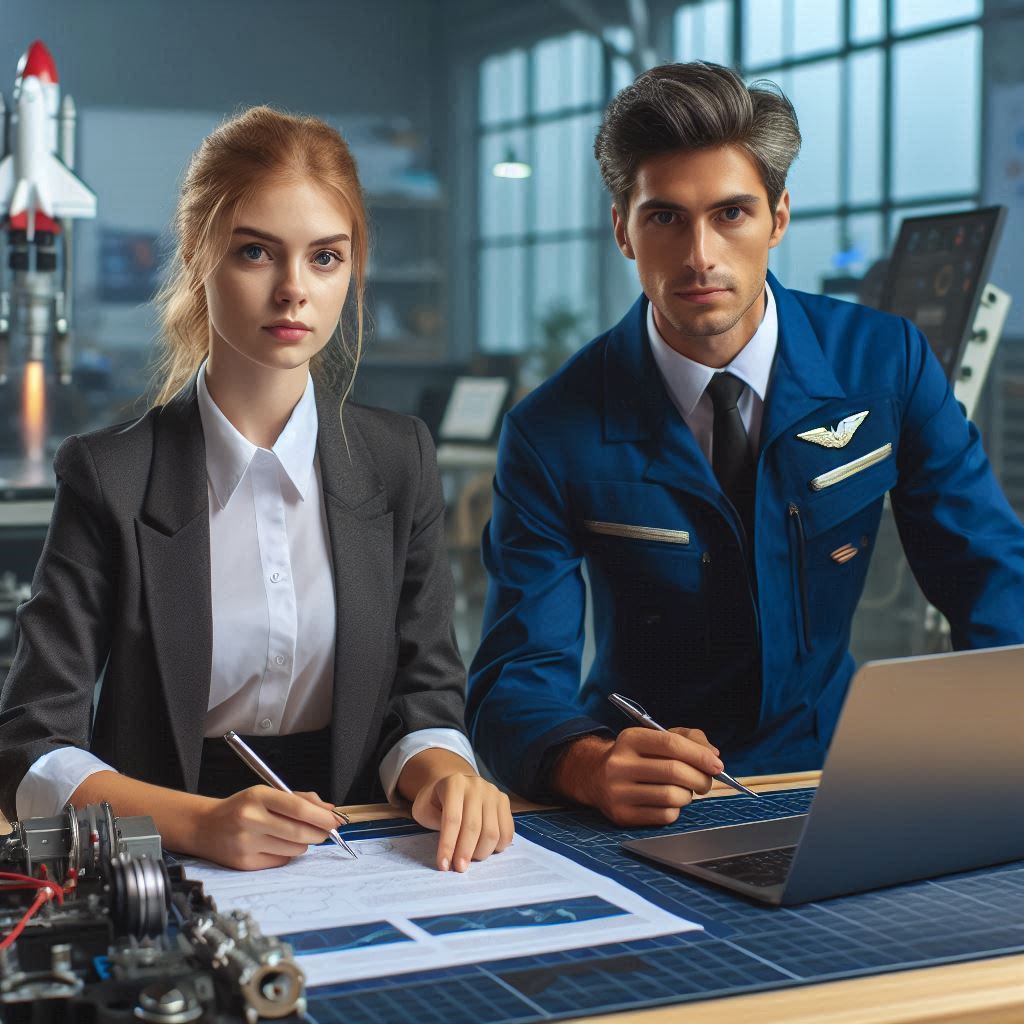Introduction
Aerospace engineering textbooks are essential resources that provide comprehensive knowledge and foundational skills critical for students and professionals in the field.
These textbooks cover a wide range of topics, from fundamental principles of aerodynamics and propulsion to advanced concepts in spacecraft design and systems engineering.
They are designed to equip learners with the theoretical understanding and practical insights necessary to tackle the complex challenges of aerospace engineering.
Textbooks serve as vital tools for enhancing students’ knowledge and skills, offering structured content that aligns with academic curricula and industry standards.
They present detailed explanations, mathematical formulations, and real-world applications that help students grasp intricate concepts.
Additionally, textbooks often include problem sets, case studies, and illustrative diagrams that reinforce learning and encourage analytical thinking.
By providing a solid educational foundation, aerospace engineering textbooks empower students to excel in their studies and prepare for successful careers in this dynamic and ever-evolving field.
Fundamentals of Astrodynamics
Understanding astrodynamics is crucial in aerospace engineering as it provides the foundation for analyzing and predicting the motion of objects in space.
This field is essential for designing spacecraft trajectories, planning satellite orbits, and ensuring successful space missions.
Mastery of astrodynamics enables engineers to solve complex problems related to space navigation, mission planning, and orbital mechanics.
Key topics covered in the textbook include
- Orbital Mechanics: Fundamental principles governing the motion of bodies in orbit, including Kepler’s laws, orbital elements, and the equations of motion.
- Trajectory Analysis: Techniques for calculating and optimizing spacecraft trajectories, including transfer orbits, rendezvous maneuvers, and interplanetary travel.
- Orbital Perturbations: Effects of gravitational forces, atmospheric drag, and other perturbative forces on satellite orbits and how to account for them.
- Mission Design: Strategies for planning and executing space missions, including launch windows, transfer orbits, and mission profiles.
- Stability and Control: Methods for maintaining and adjusting spacecraft orientation and orbit, including attitude control and station-keeping.
This knowledge can be applied in real-world aerospace projects in several ways
- Satellite Deployment: Designing and implementing precise orbits for communication, weather, and navigation satellites to ensure optimal coverage and performance.
- Space Exploration: Planning and executing missions to explore other planets, moons, and asteroids, including trajectory design for interplanetary travel and orbital insertion.
- Space Station Operations: Managing the orbit and attitude of space stations, ensuring safe docking procedures, and planning resupply missions.
- Defense and Security: Developing and maintaining satellite-based surveillance and reconnaissance systems, including orbit prediction and threat mitigation.
- Commercial Spaceflight: Supporting the growing commercial space industry with trajectory planning for crewed and uncrewed missions, including space tourism and satellite constellations.
By mastering the fundamentals of astrodynamics, aerospace engineers are equipped to tackle the complexities of space missions, contributing to advancements in satellite technology, space exploration, and commercial space activities.
Introduction to Flight
Basics of Flight Mechanics
The textbook “Introduction to Flight” covers essential topics in flight mechanics, providing a comprehensive understanding of how aircraft achieve and sustain flight. Key topics include:
- Principles of Aerodynamics: Understanding the forces of lift, drag, thrust, and weight, and how they interact to enable flight.
- Airfoil and Wing Design: Exploring the shapes and characteristics of airfoils and wings that influence aerodynamic performance.
- Flight Dynamics: Analyzing the stability, control, and maneuverability of aircraft in various flight conditions.
- Performance Analysis: Calculating the performance parameters of aircraft, such as speed, range, endurance, and fuel efficiency.
- Propulsion Systems: Studying the principles and types of propulsion systems, including jet engines and propellers, and their impact on flight.
- Aircraft Structures: Examining the design and materials of aircraft structures to ensure strength, durability, and safety.
Importance of Understanding Aerodynamics for Aerospace Engineers
Aerodynamics is a fundamental aspect of aerospace engineering, as it directly impacts the design, performance, and safety of aircraft and spacecraft.
A thorough understanding of aerodynamics allows engineers to
- Optimize Aircraft Design: By applying aerodynamic principles, engineers can design aircraft that achieve maximum efficiency, performance, and safety.
- Enhance Fuel Efficiency: Improved aerodynamic designs reduce drag, leading to lower fuel consumption and increased range.
- Ensure Stability and Control: Understanding flight dynamics and control mechanisms helps engineers design aircraft that are stable and easy to maneuver.
- Innovate New Technologies: Knowledge of aerodynamics is essential for developing cutting-edge technologies, such as advanced airfoils, wing configurations, and propulsion systems.
Practical Applications of the Concepts Learned
The concepts covered in “Introduction to Flight” have numerous practical applications in aerospace engineering, including:
- Commercial Aviation: Designing commercial airliners that optimize fuel efficiency, passenger comfort, and safety.
- Military Aircraft: Developing high-performance fighter jets and unmanned aerial vehicles (UAVs) with superior maneuverability and speed.
- Space Launch Systems: Designing aerodynamic fairings and control surfaces for rockets to ensure stable flight during atmospheric ascent.
- Aerodynamic Testing: Conducting wind tunnel tests and computational fluid dynamics (CFD) simulations to validate and refine aircraft designs.
- Renewable Energy: Applying aerodynamic principles to design efficient wind turbines for sustainable energy production.
- Sports Engineering: Enhancing the performance of sports equipment, such as racing bicycles and sails, through aerodynamic optimization.
By mastering flight mechanics and aerodynamics, aerospace engineers advance aviation technology.
They improve aircraft efficiency and safety.
Engineers also explore innovative solutions for various aerospace applications.
Aerospace Propulsion
Key Principles of Aerospace Propulsion
The textbook on aerospace propulsion covers several fundamental principles that are essential for understanding how propulsion systems work.
Key topics include
- Thermodynamics: The study of energy transfer, efficiency, and the laws of thermodynamics as they apply to propulsion systems.
- Fluid Dynamics: Analysis of how gases and fluids behave in engines and propulsion systems, including the study of compressible and incompressible flows.
- Combustion: The chemical processes involved in burning fuels to produce thrust, including the study of fuel types, combustion chambers, and flame stability.
- Propulsion Mechanics: Examination of the mechanics behind different propulsion systems, such as jet engines, rockets, and hybrid engines, including thrust generation, specific impulse, and propulsion efficiency.
- Propulsion Systems: Detailed exploration of various types of propulsion systems, including:
- Jet Engines: Turbojets, turbofans, ramjets, and scramjets, focusing on their design, operation, and applications.
- Rocket Engines: Solid and liquid rocket engines, hybrid rockets, and electric propulsion systems, including ion and Hall thrusters.
- Alternative Propulsion: Emerging technologies such as nuclear thermal propulsion, solar sails, and electromagnetic propulsion.
Role of Propulsion Systems in Aircraft and Spacecraft
Propulsion systems are critical components of both aircraft and spacecraft, providing the necessary thrust to achieve and sustain flight or space travel. Their roles include:
- Generating Thrust: Propulsion systems produce the force required to propel aircraft and spacecraft forward, overcoming drag and gravitational forces.
- Controlling Flight: In aircraft, propulsion systems help control speed, altitude, and maneuverability. In spacecraft, they enable trajectory adjustments, orbital insertions, and deorbit maneuvers.
- Mission Success: The performance and reliability of propulsion systems directly impact the success of missions, whether it‘s a commercial flight, a military operation, or a space exploration mission.
Designing More Efficient Propulsion Systems
Knowledge of aerospace propulsion principles can be used to design more efficient propulsion systems through several approaches
- Optimizing Engine Performance: By understanding thermodynamics and fluid dynamics, engineers can design engines that maximize thrust while minimizing fuel consumption, increasing overall efficiency.
- Innovating Combustion Techniques: Advances in combustion technology, such as improved fuel injectors, combustion chamber designs, and afterburners, can enhance engine efficiency and reduce emissions.
- Developing Advanced Materials: Using lightweight and heat-resistant materials can improve engine performance and durability, allowing for higher operating temperatures and pressures.
- Integrating Hybrid Systems: Combining different propulsion technologies, such as electric and chemical propulsion, can provide more versatile and efficient solutions for specific mission profiles.
- Enhancing Propulsion Control: Implementing advanced control systems and algorithms can optimize engine performance in real-time, adapting to changing flight conditions and mission requirements.
By applying these principles, aerospace engineers can develop propulsion systems that are more efficient, reliable, and environmentally friendly, contributing to the advancement of aviation and space exploration technologies.
This knowledge is essential for pushing the boundaries of what is possible in aerospace propulsion and achieving more ambitious and sustainable goals in the field.
Read: How to Become a Civil Rights Advocate
Aircraft Structures
Importance of Understanding Structural Mechanics in Aerospace Engineering
Understanding structural mechanics is crucial in aerospace engineering because it ensures that aircraft and spacecraft can withstand the various forces and stresses encountered during flight.
Structural integrity is essential for the safety, performance, and longevity of aerospace vehicles.
Engineers must design structures that are not only strong and durable but also lightweight to enhance efficiency and reduce operational costs.
Key Concepts Covered in the Textbook
The textbook on aircraft structures covers several fundamental concepts, including:
- Stress and Strain: Understanding how materials deform under various loads, including tension, compression, shear, and torsion.
- Material Properties: Studying the mechanical properties of materials commonly used in aerospace structures, such as aluminum, titanium, composites, and advanced alloys.
- Structural Analysis: Techniques for analyzing and calculating stresses, strains, and deflections in various structural components.
- Load Distribution: Understanding how loads are distributed across an aircraft’s structure, including wings, fuselage, and control surfaces.
- Fatigue and Fracture: Investigating the mechanisms of material fatigue and fracture, and how to design structures to resist these failures.
- Finite Element Analysis (FEA): Utilizing computational tools to model and simulate structural behavior under different loading conditions.
- Stability and Buckling: Examining the stability of structures and the potential for buckling under compressive loads.
Significance of Designing Strong and Lightweight Aircraft Structures
Designing strong and lightweight aircraft structures is of paramount importance for several reasons:
- Safety: Aircraft must be able to endure the loads and stresses encountered during flight without experiencing structural failure. Robust design ensures passenger and crew safety.
- Performance: Lightweight structures contribute to improved aircraft performance by enhancing maneuverability, increasing payload capacity, and reducing fuel consumption.
- Efficiency: Reducing the weight of aircraft structures directly impacts fuel efficiency, leading to lower operating costs and reduced environmental impact.
- Durability: Strong and well-designed structures resist fatigue and fracture, ensuring a longer service life and reducing maintenance and repair costs.
- Compliance: Meeting regulatory requirements and industry standards for structural integrity and safety is essential for certification and operation.
By mastering the concepts covered in the textbook, aerospace engineers can design and analyze aircraft structures that meet the stringent demands of modern aviation.
This knowledge helps create safer, more efficient, and reliable aerospace vehicles.
It advances the aerospace industry and achieves innovative engineering solutions.
Read: The Intersection: Architecture & Tech in Modern USA.
Spacecraft Systems Engineering
Importance of Systems Engineering in Spacecraft Design
Systems engineering is vital in spacecraft design as it provides a structured approach to managing complex projects, ensuring that all components and subsystems work together seamlessly.
It involves defining requirements, developing and integrating various subsystems, and verifying that the overall system meets mission objectives.
Systems engineering helps manage risks, optimize performance, and ensure that the spacecraft operates reliably in the harsh environment of space.
Interdisciplinary Nature of Spacecraft Systems Engineering
Spacecraft systems engineering is inherently interdisciplinary, involving collaboration across various engineering disciplines. Key areas include:
Transform Your Career Today
Unlock a personalized career strategy that drives real results. Get tailored advice and a roadmap designed just for you.
Start Now- Mechanical Engineering: Designing and analyzing structural components to withstand launch loads and space conditions.
- Electrical Engineering: Developing power systems, avionics, and communication systems to ensure reliable operation and data transmission.
- Thermal Engineering: Managing heat generated by electronic components and external sources to maintain optimal operating temperatures.
- Software Engineering: Creating and testing onboard software for navigation, control, and data processing.
- Aerospace Engineering: Addressing propulsion, trajectory analysis, and orbital mechanics to achieve mission goals.
- Materials Science: Selecting and testing materials that can withstand the space environment, including radiation and extreme temperatures.
This interdisciplinary collaboration ensures that all aspects of the spacecraft function together as an integrated system, meeting stringent performance and reliability requirements.
Examples of Successful Spacecraft Projects Utilizing Systems Engineering Principles
Several high-profile spacecraft projects have successfully utilized systems engineering principles:
- Apollo Program:The complex integration of the Saturn V rocket, the Lunar Module, the Command Module, and support systems required meticulous planning, coordination, and testing to achieve manned lunar landings and safe returns.
- Mars Curiosity Rover: The Mars Science Laboratory mission, featuring the Curiosity rover, demonstrated successful systems engineering in landing a car-sized rover on Mars.
- Hubble Space Telescope: The mission involved collaboration across optics, structural engineering, thermal control, and attitude control systems to ensure high-resolution imaging of the universe.
- James Webb Space Telescope (JWST): The JWST represents a pinnacle of systems engineering in space exploration. Its complex deployment sequence, large segmented mirror, and advanced scientific instruments required precise integration and testing to ensure successful operation in space.
- International Space Station (ISS):Its construction, operation, and maintenance required coordinated systems engineering to integrate various modules, life support systems, power generation, and scientific research facilities.
By employing systems engineering principles, these projects managed the complexities of spacecraft design, ensuring that all subsystems functioned together to achieve mission success.
This approach continues to be essential for advancing space exploration and developing innovative aerospace technologies.
Read: Economic Indicators and Their Influence on US Architects
Find Out More: The Role of Aerospace Engineers in Drone Technology
Flight Vehicle Aerodynamics
Principles of Aerodynamics Specific to Flight Vehicles
The principles of aerodynamics for flight vehicles focus on understanding and optimizing how air flows around and interacts with aircraft structures.
Key concepts include
- Lift and Drag: Lift is the force that enables an aircraft to rise, generated by the difference in pressure between the upper and lower surfaces of the wing. Drag is the resistance force opposing the aircraft’s motion. Balancing these forces is crucial for efficient flight.
- Airfoil Design: Airfoils are the cross-sectional shapes of wings or other lifting surfaces. The design of airfoils affects how effectively lift is generated and how drag is minimized. Key characteristics include camber, thickness, and angle of attack.
- Flow Characteristics: Understanding how airflow behaves around the aircraft, including laminar and turbulent flow, is essential for optimizing performance and minimizing drag.
- Stall and Post-Stall Behavior: Stall occurs when the airflow over the wing is disrupted, causing a loss of lift. Understanding stall characteristics and recovery methods is crucial for safe flight operations.
- Control Surfaces: Components like ailerons, elevators, and rudders control the aircraft‘s orientation and stability. Their design and placement affect maneuverability and handling.
- Aerodynamic Optimization: Techniques such as winglets, fairings, and streamlined shapes are used to reduce drag and improve overall aerodynamic efficiency.
Importance of Aerodynamic Design in Aerospace Engineering
Aerodynamic design is a cornerstone of aerospace engineering, as it directly impacts the performance, efficiency, and safety of flight vehicles.
The importance includes
- Performance Enhancement: Efficient aerodynamic design improves the aircraft’s speed, maneuverability, and overall flight performance by reducing drag and optimizing lift.
- Fuel Efficiency: Streamlined designs reduce aerodynamic drag, leading to lower fuel consumption and extended range, which is crucial for both commercial and military aircraft.
- Safety and Stability: Proper aerodynamic design ensures stable flight characteristics, reduces the risk of stalls, and enhances control, contributing to overall safety.
- Environmental Impact: Improving aerodynamic efficiency reduces fuel consumption and emissions, aligning with environmental and regulatory standards for sustainable aviation.
Using Knowledge to Improve Performance and Efficiency
Applying aerodynamic knowledge to flight vehicle design can lead to significant improvements in performance and efficiency through several strategies
- Advanced Airfoil Designs: Utilizing optimized airfoil shapes can enhance lift-to-drag ratios, improving overall aerodynamic efficiency and performance.
- Wing Configurations: Designing wings with features like variable geometry, winglets, or high-aspect ratios can reduce drag and enhance lift, leading to better fuel efficiency and handling.
- Streamlined Shapes: Incorporating streamlined shapes and smooth surfaces minimizes drag and turbulence, resulting in better speed and fuel efficiency.
- Active Aerodynamics: Implementing technologies like active control surfaces and adaptive wing designs can dynamically adjust to optimize performance during different flight conditions.
- Computational Fluid Dynamics (CFD): Using CFD simulations to analyze and refine aerodynamic designs allows for more accurate predictions and optimizations before physical testing.
- Wind Tunnel Testing: Conducting wind tunnel tests provides valuable data on aerodynamic performance, allowing engineers to validate and improve designs.
Aerospace engineers leverage aerodynamic principles and techniques to design flight vehicles.
These designs achieve higher performance, better efficiency, and enhanced safety.
This knowledge is fundamental to advancing aerospace technology and meeting the evolving demands of the aviation and space industries.
Read: Post-Pandemic Design Trends: US Architects Adapt

Aerospace Materials and Manufacturing
Types of Materials Used in Aerospace Engineering
Aerospace engineering relies on a diverse range of materials to meet the demanding requirements of flight and space missions.
Key materials include
Metals
- Aluminum Alloys: Widely used for aircraft structures due to their high strength-to-weight ratio and excellent corrosion resistance. Common alloys include 2024 and 7075.
- Titanium Alloys: Valued for their high strength, low density, and resistance to extreme temperatures. Used in critical components such as engine parts and structural elements.
- Stainless Steel: Provides excellent strength and corrosion resistance, used in components exposed to high temperatures and harsh environments.
Composites
- Carbon Fiber Reinforced Polymers (CFRP): Known for their high strength and low weight, CFRPs are used in aircraft structures, such as wings and fuselage, and in spacecraft.
- Glass Fiber Reinforced Polymers (GFRP): Less strong than carbon fiber but more cost-effective, used in less critical applications.
Ceramics
- Advanced Ceramics: Used in high-temperature applications such as rocket nozzles and thermal protection systems due to their excellent heat resistance and thermal insulation properties.
Polymers
- Thermoplastics: Used in various aerospace components, including interior parts and some structural elements, for their ease of processing and flexibility.
- Thermosetting Plastics: Provide high strength and thermal stability, used in composite matrices and coatings.
Manufacturing Processes in Aerospace Component Production
Aerospace manufacturing involves several advanced processes to produce high-quality components
- Casting: Molten metal is poured into molds to create complex shapes, commonly used for engine parts and structural components.
- Machining: Cutting, drilling, and shaping materials using CNC machines to achieve precise dimensions and tolerances.
- Forging: Metal is shaped by applying compressive forces, enhancing material strength and integrity, often used for critical structural components.
- Composite Layup: Layers of composite materials are arranged and bonded together using resin to create lightweight and strong structures. Techniques include hand layup, automated tape laying, and filament winding.
- Additive Manufacturing (3D Printing): Builds components layer by layer using materials like metals, polymers, and composites, allowing for complex geometries and rapid prototyping.
- Assembly: Components are assembled into final structures using various techniques, including welding, riveting, and adhesive bonding.
Importance of Selecting the Right Materials for Aerospace Applications
Selecting the right materials is critical in aerospace engineering due to the following factors:
- Performance: Materials must meet specific performance criteria such as strength, stiffness, and fatigue resistance to ensure the structural integrity and functionality of aerospace vehicles.
- Weight: Lightweight materials contribute to improved fuel efficiency and payload capacity, crucial for both aircraft and spacecraft.
- Durability: Aerospace materials need to withstand extreme conditions, including high temperatures, radiation, and corrosive environments, without degrading.
- Cost: The choice of materials affects the overall cost of manufacturing and maintenance. Balancing performance with cost is essential for project feasibility.
- Safety: Reliable materials ensure that aerospace components perform as expected under various operational conditions, reducing the risk of failure and ensuring safety.
Engineers use their expertise in materials and manufacturing to develop aerospace components.
They ensure these components meet stringent requirements and withstand extreme conditions.
This expertise is fundamental to advancing aerospace technology, improving vehicle performance, and ensuring safety and reliability in flight and space missions.
Conclusion
In this post, we explored several key textbooks that are fundamental to studying aerospace engineering.
These books cover a broad range of topics, including the core principles of aerodynamics, propulsion systems, structural analysis, and spacecraft design.
Each textbook offers unique insights and detailed explanations that are crucial for understanding both basic and advanced concepts in aerospace engineering.
We emphasized how these textbooks provide a comprehensive foundation for students and professionals alike.
They include detailed examples, problem-solving techniques, and case studies that help clarify complex topics.
Additionally, these resources offer up-to-date information on technological advancements and industry standards.
Using aerospace engineering textbooks is vital for enhancing your knowledge and skills in the field.
They not only support academic learning but also contribute to professional growth.
By engaging deeply with these texts, you gain a thorough understanding of essential concepts and stay current with ongoing innovations.
Incorporating these textbooks into your studies and career development will significantly benefit your expertise in aerospace engineering.
They are invaluable tools for mastering the principles and applications of the field.
Investing time in these resources ensures that you are well-equipped to tackle challenges and contribute effectively to the aerospace industry.




